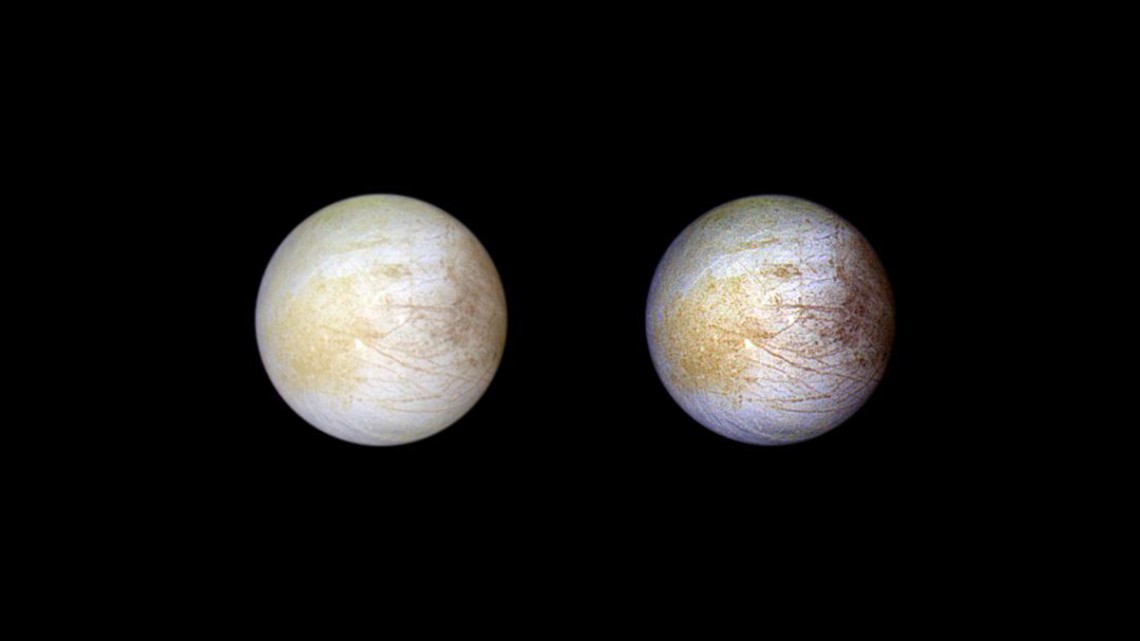
This color composite view shows the moon Europa in natural color (left) and in enhanced color (right). The yellowish patch is Tara Regio, the geologic region where the most CO2 is seen and where Hubble recently detected ocean-derived salt.
Webb telescope finds carbon source on Jupiter’s Europa
Astronomers using data from NASA’s James Webb Space Telescope have identified carbon dioxide on the icy surface of Jupiter’s moon Europa – one of a handful of worlds in our solar system that could potentially harbor conditions suitable for life.
Previous research had shown that beneath Europa’s water-ice crust lies a salty ocean of liquid water with a rocky seafloor. However, planetary scientists had not confirmed if that ocean contained the chemicals needed for life, particularly carbon.
This new analysis indicates that the carbon dioxide likely originated in the subsurface ocean and was not delivered by meteorites or other external sources. Moreover, it was deposited on a geologically recent timescale. This discovery has important implications for the potential habitability of Europa’s ocean.
“We now think that we have observational evidence that the carbon we see on Europa’s surface came from the ocean. That’s not a trivial thing. Carbon is a biologically essential element,” said Samantha Trumbo, a 51 Pegasi b postdoctoral fellow in the Department of Astronomy in the College of Arts and Sciences, lead author of one of two independent papers analyzing these data.
Trumbo’s paper, “The Distribution of CO2 on Europa Indicates an Internal Source of Carbon,” published Sept. 21 in Science. Michael Brown of the California Institute of Technology was the co-author.
“On Earth, life likes chemical diversity – the more diversity, the better. We’re carbon-based life. Understanding the chemistry of Europa’s ocean will help us determine whether it’s hostile to life as we know it, or if it might be a good place for life,” said Geronimo Villanueva of NASA’s Goddard Space Flight Center in Greenbelt, Maryland, lead author of the second paper describing the findings.
Webb found that on Europa’s surface, carbon dioxide is most abundant in Tara Regio – a geologically young area of generally resurfaced terrain known as “chaos terrain.” The surface ice has been disrupted, and there likely has been an exchange of material between the subsurface ocean and the icy surface.
“Previous observations from the Hubble Space Telescope show evidence for ocean-derived salt in Tara Regio,” Trumbo said. “Now we’re seeing that carbon dioxide is heavily concentrated there as well. We think this implies that the carbon probably has its ultimate origin in the internal ocean.”
“Scientists are debating how much Europa’s ocean connects to its surface. I think that question has been a big driver of Europa exploration,” said Villanueva. “This suggests that we may be able to learn some basic things about the ocean’s composition even before we drill through the ice to get the full picture.”
Carbon dioxide isn’t stable on Europa’s surface. Therefore, the scientists say it’s likely that it was supplied on a geologically recent timescale – a conclusion bolstered by its concentration in a region of young terrain.
NASA plans to launch its Europa Clipper spacecraft, which will perform dozens of close flybys of Europa to further investigate whether it could have conditions suitable for life, in October 2024. These findings may help inform that mission, as well as the European Space Agency’s upcoming Jupiter Icy Moons Explorer (JUICE).
Media Contact
Get Cornell news delivered right to your inbox.
Subscribe
